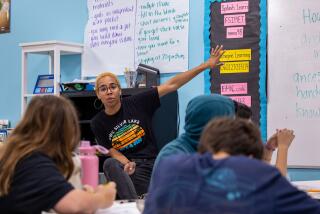Giving Thanks for Fewer Little Blessings
- Share via
Just before Halloween, 10 of my first-graders lined up and marched off to their new classroom and teacher. It was a bittersweet personal moment. We had all been together since July 1 and none of us wanted to say goodbye.
But as a teacher, I was elated. I never believed I ‘d live to see the day that I would be asked to teach only 20 children. The new teachers had been hired in September and had been working in our classrooms daily, learning the ins and outs of first grade and the individual characters of their eventual students. There had been many hugs between my “extra” 10 and their new teacher. They loved her already.
Our school in North Hollywood is so severely overcrowded that we teach a longer school day and rotate three tracks of classes through a year-round schedule. It was no easy task to add six extra rooms in order to reduce class size to 20 in grades one and two. The district delivered four portable rooms in September, and we all rejoiced. Soon we found out that more electricity would be needed. Power lines, poles, transformers, trenches would take months to install. Hearts sank. “It just won’t happen here. Not this year,” we thought. Suddenly, a generator was brought in and the rooms were made habitable. The children lined up and said goodbye.
My colleagues and I have waited years for an opportunity to teach smaller groups of children. We’ve cried in frustration when we were criticized for low reading scores, “How can we teach so many needy children at once?” “Give me a smaller class size and I’ll show them test scores!” Well, they have. Twenty first graders. What is it like?
It is startling. The difference is more that I anticipated. The first thing I noticed was the peacefulness. I can’t say my 6-year-olds work silently, but 20 busy little people are decidedly quieter than 32. I can hear the child who is reading to me. The energy level of the room is simply less. My attention is not consumed in scanning the room to determine who is working and who is not. I can pinpoint the loud or playful individual quickly and bring her back on task. As a result, I can demand more of each child. I can tell Jose that his paper is not acceptable and require him to do it again. I can check Gloria’s excellent work, praise her and reward her with a fun and enriched activity.
Then there is the space. Tables and chairs for 10 children were also removed. Now we can move around the room without knocking backpacks off chairs every time we walk past a table. Fewer bumps and pushes equal fewer squabbles. We’ve had time for every child to read his written work to the group. We can have a class discussion and allow everyone a chance to speak. In a classroom like mine, where over 90% of the children speak English as a second language, there is an enormous need to practice new language skills. This takes time. Now we have the time.
My colleagues and I have shared our first few weeks’ experiences and we all agree on the marvelous opportunity this 20 student classroom offers. We are giddy with the possibilities. We are sobered by the determination to prove that this will work--in each classroom, in overall scores for our school, and ultimately at the state level. We desperately want the public to see that we can make a difference. We can teach every child to read. We can succeed in raising scores. And we are so glad to have been given the conditions that will allow us to do so.






